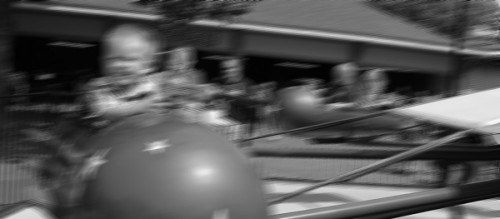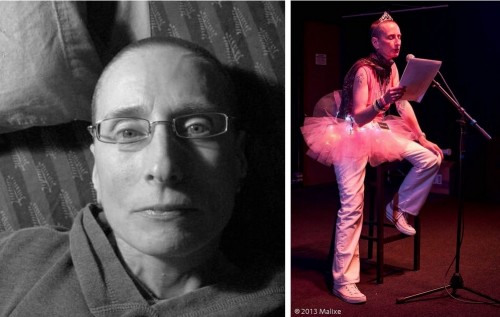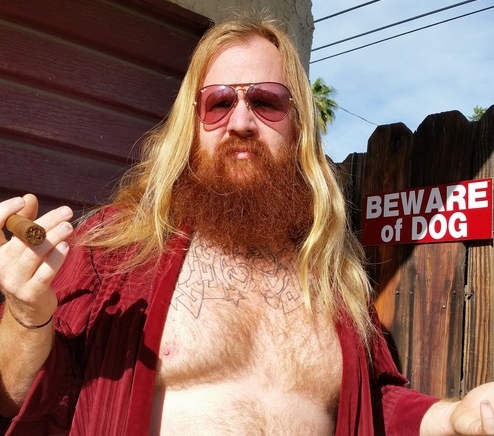25 Points: Man Alive

Man Alive: A true story of violence, forgiveness and becoming a man.
by Thomas Page McBee
City Lights/Sister Spit 2014
172 pages. $11.17 Buy from: City Lights
- This is a memoir of transitions, journeys, and radical love/forgiveness.
- In this memoir, Thomas’ tells the story of his transition to manhood alongside his account of being robbed at gunpoint.
- I’m so glad this book exists. I’m so glad Sister Spit’s new imprint under City Lights exists. I’m so glad Thomas Page McBee exists to have written it.
- There is a very palpable danger in this book. Matthew Shepard and Brandon Teena’s names flicker in the background as Thomas traverses the middle of the country, anxiously hoping that he passes as male during every interaction with surly bartenders and gas station clerks.
- Thomas and I were in the same writing program at SFSU eons ago when he was a poet. He has always been a kind, thoughtful chum.
- Thomas was the “masculinity expert” for VICE and writes the column “Self Made Man” for The Rumpus.
- This book gives a nuanced look at male privilege and gender constructs: Thomas acknowledges his male privilege within his terrifying robbery. The mugger gives directions to him, trains his eyes on him, points his gun at him. Thomas’ female companion, Parker, is a shadow, her words are ignored by the mugger, who eventually, reluctantly takes her credit card. I think this moment is a nice metaphor for the privileges and pitfalls of masculinity. Thomas, the man, is taken seriously, is heard and seen. Thomas, the man, is thrown to the ground, is expected to absorb violence and keep his composure. When Thomas speaks, his voice still high and feminine, as he has not yet started taking hormones, the mugger lets him go.
- Parker is such a lovable character (and great person in real life). She is supportive and honest and tough and sassy and smart and blurts out things like “wherever you are, whoever you are, you have a right to be here.”
- You get a sense of the strain that Thomas’ transition, all the societal implications that go with this change, the mugging, take a serious toll on he and Parker’s relationship, and that’s super sad, because these people are clearly so much in love.
- This book is filled with men doing awful things: There’s the robbery. A murder. The racist and vengeful court system. There’s Thomas’ father molesting him, when he was a young girl. There’s a dark family history full of incest and abuse.
- Anger is like the one sacred emotion that traditional gender norms have allowed men. Vengeance is the medium of expression. Thomas’ memoir rejects this construct and refuses to turn men into “monsters.” Again and again, Thomas refuses to succumb to vengeance. He acknowledges that a fistfight or a drunken argument is the prescribed remedy for men who’ve hurt each other, yet he does the best he can to SEE the men who’ve injured him. He refuses to reduce men to their worst acts by acknowledging their transgressions alongside their suffering. He tries again and again, as best he can to forgive them.
- Thomas used to edit a fashion blog called The Ironing Board Collective where he wrote about his style sense, his ideal body type (essentially Paul Newman at his hottest), Kanye West, etc.
- Here are two little sections I love:
- I looked so much like a teenage boy that I’d mostly forgotten my difference. It was only at odd moments that I’d pass a mirror and see shapes that shouldn’t be there, a stranger who looked like me but wasn’t me at all, a stranger like a kick in the chest.
- You’d have to be pretty destroyed to hold a gun to another person’s face and shoot it, I thought. And you’d have to have abandoned yourself to the core to want to annihilate a child.
- You know the particularly joyful, cathartic, queasy feeling of removing a frighteningly long ingrown hair, snipping out old stitches, squeezing pus out of a weeping wound? That’s what reading this book is like.
- I’d recommend this book to: Survivors of abuse. Men who aren’t satisfied with mainstream or even so-called alternative portrayals of masculinity. People who are in relationships with people who are transitioning. White people who feel confused/guilty about gentrifying their neighborhood. Victims of violent crime. Perpetrators of violent crime. People with violent dads. People with neglectful moms. People who do their best to love them anyway. Everybody else.
- With all the stories people are sharing around sexual violence/coercion/rape within the “alt-lit” scene, I keep thinking about restorative justice ( defined as “a system of criminal justice that focuses on the rehabilitation of offenders through reconciliation with victims and the community at large.”) The 6-12 school in Brooklyn where I work tries it’s best to use restorative justice models to address behaviors that range from mundane (talking in class) to horrendous (sexual predation/violence/etc.) Restorative practices compared to more traditional punitive approaches (which exclude victims and offenders from the justice process) take a great deal more resources: time, energy, follow through, patience, humility, generosity, self awareness, etc. Man Alive displays the work restorative justice requires: the difficult conversations between the abuser and the survivor, the soul searching Thomas must do to come to a place that resembles forgiveness, the pain Thomas bravely faces in order to move forward into a new gender identity, a new place, a new life…
- Men are committing most of the raping, abusing, acts of intimate violence. Therefore it’s critical that men are educated around these issues. This book is an important piece of that discussion.
- Now that I’m almost done writing about Thomas’ book, I plan to give it to this one trans student I have who I hope will enjoy reading it, although I fear she’s not a skilled enough reader to make sense of it all. Are there good books about transitioning for teens with low reading levels? LMK!?
- Here’s some more stuff from the book I liked:
- “Court is now in session,” the bailiff announced… “Please rise,” he said; and I thought of church as we, as one, did.
- A wedding had seemed the perfect opportunity to dress up like adults, and somehow magically become them.
- This book ends in the ocean as all things should.
- I <3 Man Alive.
October 7th, 2014 / 9:07 am
Jonathan Interview (Brooklyn)
Q: Was your writing encouraged at home?
A: Mostly not, no.
Q: Have you matured as a writer?
A: What is my hot material? My Midwestern childhood, my parents, their marriage.
A: I’m that oddity of a writer who had a good high-school experience.
A: I had an idea of the social novel that I didn’t realize was already outmoded.
A: But that didn’t stop me from trying to write a Corrections-like book.
Q: Is that obsession with appearances still a concern to you?
A: Most of the book.
Q: You’ve described your first two books as “systems novels.”
A: Cigarettes had made me smart, and smart had been the organizing principle for a couple of books. Smart had been the locus of my manhood, but it was no longer getting me anywhere.
Q: Blake Butler?
A: I built an office up in Harlem in 1997. The people at the Swedish Academy, who bestow the Nobel Prize, recently confessed their thoroughgoing lack of interest in American literary production. The conflict in my marriage could no longer be ignored.
Self-Publishing Question
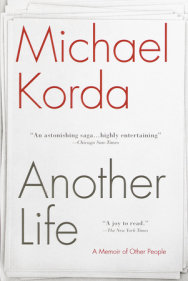
The internet since the early 2000s has made it possible to achieve a much higher profile, though the requirements are the same; you have to work hard, have reasonable expectations, and be cool in the world in order to be successful. But the potential for success in terms of readership is greater.
25 Points: Sorrow Arrow
 |
Sorrow Arrow
by Emily Kendal Frey
Octopus Books, 2014
92 pages / $12.00 buy from Octopus Books
|
1. I read Sorrow Arrow in June.
2. “What was the last book you read/what was your favourite, lately?” A friend of mine who was out of town for the summer sent me this text message. I told her it was Sorrow Arrow by Emily Kendal Frey. When she got back into town a few months later I loaned it to her.
3. If you’re like me, once a year or so, you read a book that makes you rethink the way you’ve been writing entirely and you come away from it sure beyond a shadow of a doubt that the only way to write is the way that writer does it.
4. Sorrow Arrow was one of those books. When I was finished with it I just felt the entirety of all the poetry I’d ever written pass into obsolescence.
5. My first exposure to Emily Kendal Frey was when we both had prose poems published in Issue 6 of Banango Street in January. I felt privately certain they only published my poem because it was a prose poem roughly the same length as hers and together the two felt like they were kin somehow — cousins of about the same age who look just like each other but only met for the first time in their late teens. Hers was the more successful cousin by far.
6. I added her on Facebook and a few weeks later she posted as a status the sentence “She is born!” and the book’s cover, a faceless blankness wrapped in a green wreath, whirling, encircling sheaves of grass.
7. Two weeks later she posted that the book was available for order and I ordered it immediately.
8. Here is one of the poems: “A radiation plume is making its way to us/We write it down so we won’t think/Lap dogs sprinkled with acid snow/I got on the plane and sat back/Out the window I regretted complaining/I’m sorry I wasn’t able to get inside your color/The sky was cobalt, deafening/I die so I can live/Outside category” (p. 57)
9. At the centre of Sorrow Arrow is a tragedy. There is a tragedy at the centre of every great book of poetry, I imagine.
10. Frey’s tragedy runs through the poems—none of which have titles—like a skein of gold, a vein you can see just beneath the skin, a tungsten wire that glows bright and hot to the touch.
October 6th, 2014 / 12:00 pm
Lydia Swartz : Why Shld I Read YOUR Book ??
ok, Lydia, so why should we read YOUR book ???
Reasons to read Shufflepoems, forthcoming from Minor Arcana Press. Shuffle & read them in any order:
It’s not a book. It’s a deck of poems. Which you shuffle, so.
It’s the same temperature as your flesh, unless you’re a zombie.
If I go back to writing about pain, you will be sorry.
Can you follow a recipe? Does that necessarily mean you have to?
You’re blocked up like a constipated rooster. Pull a card. Then write/paint/dance about it.
Sometimes you read sitting down. Sometimes you read standing up or lying down. Sometimes you read walking. Or in the tub. Or in a moving vehicle.
Have you checked out the Minor Arcana Press staff? Cuu-uuuute!
I know where you live, possibly.
My ass was never my fortune, but my tits aren’t bad. READ MORE >
2010 – 2011 Minnesota Timberwolves
Prior to the 2010-2011 NBA season, I conceived of an ambitious project to write short, non-fiction prose poem biographies of all ~400 NBA players. I started with the Minnesota Timberwolves, who, at the time, had one of the more eclectic rosters in the league. After maybe 40 hours of writing, I finished nine biographies and gave up on the project as a whole. I tried submitting the results to prominent literary journals of the time (6×6, La Petit Zine, Diagram, jubilat), wistfully hoping someone would see some merit in them. No one did.
Two years later, Tim and Gene were kicking around an idea for an HTMLGiant newsletter-type publication, which would include original writing next to interviews and other articles (I think?). Tim asked if I had anything to contribute; I think the only guideline was “something chill re: style.” I sent the Minnesota Timberwolves bios and they were enthusiastically accepted, but the newsletter never fully materialized.
Things change and things don’t change. I still like these a lot and thought I’d share them. S/O Tim, Gene, and Blake.
2010 – 2011 Minnesota Timberwolves
Brian Cardinal
Brian Cardinal is the only player in Purdue University history to receive the “Mr. Hustle” and “Courage” awards four years in a row. In college he received the nickname “The Custodian.” He has played for 5 NBA teams in 10 years. On September 18th 2009, he tweeted about being stuck on an airplane. As a member of the Minnesota Timberwolves, he was traded to the New York Knicks, waived from their roster, then re-signed by the Timberwolves 35 days later.
Corey Brewer
Corey Brewer is 6’9” and weighs 185 pounds. He is the son of Pee Wee Brewer, a garbage collector. In college, he missed 3 games due to mono. He recorded the first ever triple-double in University of Florida history with 15 points, 10 rebounds, and 13 assists in a 43-point blowout of Jacksonville University. He also drew 6 defensive charges in that game.
Michael Beasley
Michael Beasley attended 6 schools in 5 states during his 4-year high school basketball career. He was kicked out of prestigious Oak Hill Academy after writing his name on the headmaster’s car. He has two sisters: Mychaela Beasley and Tiffany Couch.
Kevin Love
Kevin Love is a nephew of Mike Love, a member of the Beach Boys. His dad is Stan Love, a former NBA and ABA player. On November 12th 2010, he scored 31 points and grabbed 31 rebounds. He was named the 2010-2011 NBA’s Most Improved Player. He was once featured in an episode of Sports Science making a 90-foot shot in 98 attempts.
Wayne Ellington
In his freshman year at the University of North Carolina, Wayne Ellington scored 19 points on his 19th birthday. The Tar Heels won that game, 89-98. The next year, in a Final Four game against Kansas, he scored 18 points. The Tar Heels lost that game. In the 2009 National Championship game, Wayne scored 19 points, the Tar Heels won, and he was named the tournament’s most outstanding player. His girlfriend wears a shoe size 8.
Wesley Johnson
On March 4th 2010, he tweeted “Yeah I’m 22 get over it!!!” In an interview, he said if he had a time machine, he’d “go forward in time… hundreds of years.”
Darko Milicic
Darko Milicic was drafted by the Detroit Pistons with the 2nd pick in the 2003 draft, ahead of future superstars Carmelo Anthony (drafted 3rd), Chris Bosh (4th), and Dwyane Wade (5th). Along with Sam Bowie, who was drafted ahead of Michael Jordan in 1984, Darko is widely considered one of the most regrettable draft picks in NBA history. On December 8th 2008, Darko tore his jersey in half after being called for a foul. The jersey was later auctioned off for charity, raising $927 for St. Jude Children’s Research Hospital in Memphis.
Anthony Randolph
Anthony Randolph was born in Germany to American parents serving in the military. He is 6’11” and has been lauded for his length, versatility, and athleticism, but criticized for his on-court decision making. He is left handed. He has played for 3 teams in 4 seasons. One assistant coach said he is “still trying to find out who he is as a basketball player.” On October 28th 2010 he attended his first hockey game.
Jonny Flynn
Jonny Flynn was drafted with the 6th overall pick in 2009. He is 6 feet tall and 185 lbs. On May 3rd 2010, he tweeted “Sitting, staring at a blank screen. Deciding whether or not I should sit in silence.” On May 27th 2010, he tweeted “I wonder what kobe is thinking.” On October 30th 2010, he tweeted “I HATE movies that have animals dominating humans in sports!” On December 9th 2010, he tweeted “Nas lost me after he started talking about the Solar system and all that.” On February 6th 2011, he tweeted “Sometimes I don’t understand the things I see.” On February 10th 2011, he tweeted “I’m in a cab, in another city and the driver is asking me for directions.” He hasn’t tweeted anything since.
Sport and Prose in Kerry Howley’s Thrown
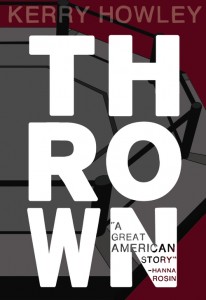 Thrown
Thrown
by Kerry Howley
Sarabande Books, Oct. 2014
288 pages / $15.95 Buy from Sarabande Books and Amazon
I had no sight into Daisy’s heart, but I felt that Tom would drift on forever seeking, a little wistfully, for the dramatic turbulence of some irrecoverable football game.
— F. Scott Fitzgerald
Gravity forgot me. I was the goalie in a pick-up soccer game in high school. My friend kicked a beautiful curling shot from just beyond the eighteen meter line; a quality of kick that elicits sharp breaths from attentive spectators. I jumped, deflected the shot over the cross-bar, and then. I was just. In space. Weightless. Drifting. Orientationless. Or rather, what orientation I had shuffled realms of sensing, considered foreign methods of angle and duration. I couldn’t tell you where I was or how I got there.
My back slammed onto the ground. The angle of my jump, the force of the shot, my singular focus on making the save, and my lack of expertise in such moments combined to turn me horizontal in mid-air. My body dispersed, but a bound self persisted enough that I vividly remember this instant of free-fall.
Many people, through many routes, have pursued similar fleeting moments; moments when nothing needs to make sense and nothing needs to be sensed because we have been removed from the mundane requirements to sense and make sense. Depending on the tenor of your philosophy, you might call this phenomenon “enlightenment,” “nirvana,” “losing yourself,” “bliss,” or any permutation, step towards, or variant thereof. Kerry “Kit” Howley might call it “ecstasy” or “ecstatic experience;” a specific usage of the term drawn from Schopenhauer and phenomenology.
Thrown, Howley’s chronicle of the pursuit of this “ecstasy” is The Great Gatsby from Gatsby’s perspective, but instead of a beautiful woman with whom the fresh potential of young love was shared, Howley courses an experience of hyper-aware ecstasy that Kit stumbled into first while escaping a beigely debilitating “conference on phenomenology, where a balding professor stunningly wrong about Husserlian intentionality dominated the postconference cocktail hour.” (p3) Kit, “[h]aving nothing to do in Des Moines beyond explore Husserl with nonsmokers who did not understand him[…]walked the conference hallways,” until she encountered this moment of ecstasy in a Mixed Martial Arts (MMA) match featuring Sean Huffman. Soon after, she encountered that experience again through the martial efforts of Erik Koch. Then Kit pursued that ecstasy through thousands of miles of travel, months of stagnation, and unsatisfying moments, even abandoning her own philosophy degree. And she pursued without waver, without doubt, and with a rare prose confidence. I’ll say this now because other themes and ideas will pull me away from this moment, because there are questions of narration and “fiction” I will not answer, because I’m a person and so will grapple with the ideas that connect to my emotions, because there will not be another chance, and because it is thrilling to say this; very few works of contemporary anything compare to the opening chapter of Thrown.
This is Howley’s ecstasy from Erik:
This moment lasts for days. We can only open our mouths in a united wordless moan. We are each of us simple tools of perception, free of the cloudying intellect, allowed a thinking of the body only accessible when men like Erik can[…]lead us outside ourselves. (p175)
And her ecstasy through Sean:
You’re not supposed to be able to live here, at this pitch, for more than a moment. But Sean, again and again, finds a way to stretch that single moment of ecstatic bliss into minute upon minute of blood-borne release. He is escaping through the slice in his forehead, the knuckle-cuts, the rip down the line of his nose, and it is possible to believe for fifteen short minutes, that we’ve found a way out. (p155)
October 6th, 2014 / 10:00 am

